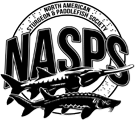Joel Van Eenennaam got his MS degree with Dr. Serge Doroshov in 1985 at UC Davis. He became a Research Associate in the Department of Animal Science at UC Davis where he worked for over 30 years. Joel played an integral role in the early stage of the White Sturgeon Broodstock and Development Program in California. To this day, he continues to help farms around the country with their sturgeon aquaculture programs. He has considerable expertise in the areas of reproductive physiology and early development, identification of sex and stage of maturity, reproductive abnormalities, and the causes and effect of spontaneous autopolyploidy.
Joel has worked with all of the North American sturgeons and paddlefish. He has published over 60 peer reviewed publications, a book chapter, numerous technical reports, and outreach publications. Most notably, Joel co-authored a series of indispensable outreach documents detailing essential procedures in assessing reproductive readiness of sturgeon.
Joel’s lengthy academic and industry contributions alone make him well deserving of being honored with the Order of Acipenser, but we cannot ignore his contributions as a colleague, mentor, teacher, and friend. Countless students, post-docs, and visiting scientists at UC Davis have worked with Joel, benefiting from his vast knowledge, patience, kindness, and desire to teach. It is impossible to quantify how many people – students, faculty, agency scientists, aquaculture specialists, and more, in California, the United States, and internationally – Joel has taught how to spawn, hatch, rear, handle, maintain, sex, and perform surgery on sturgeon.
